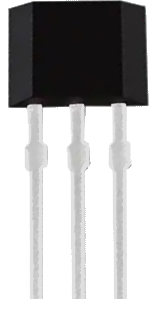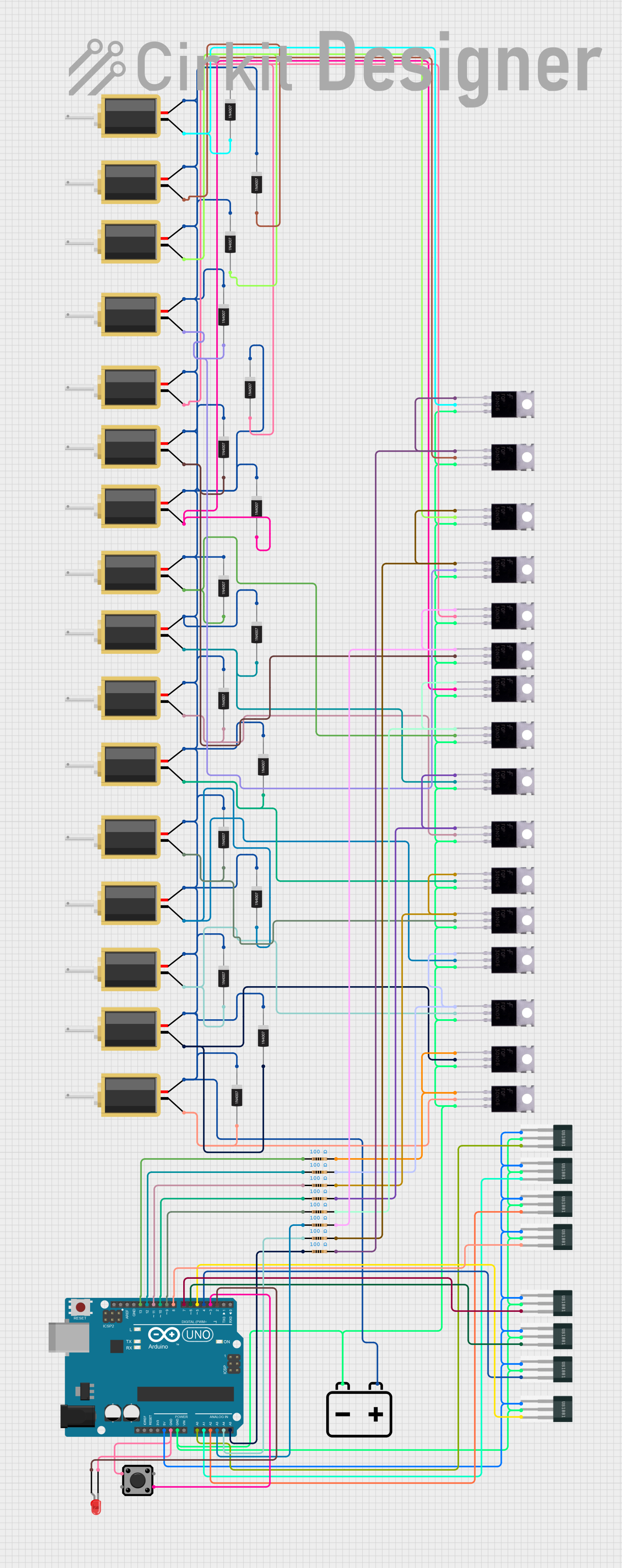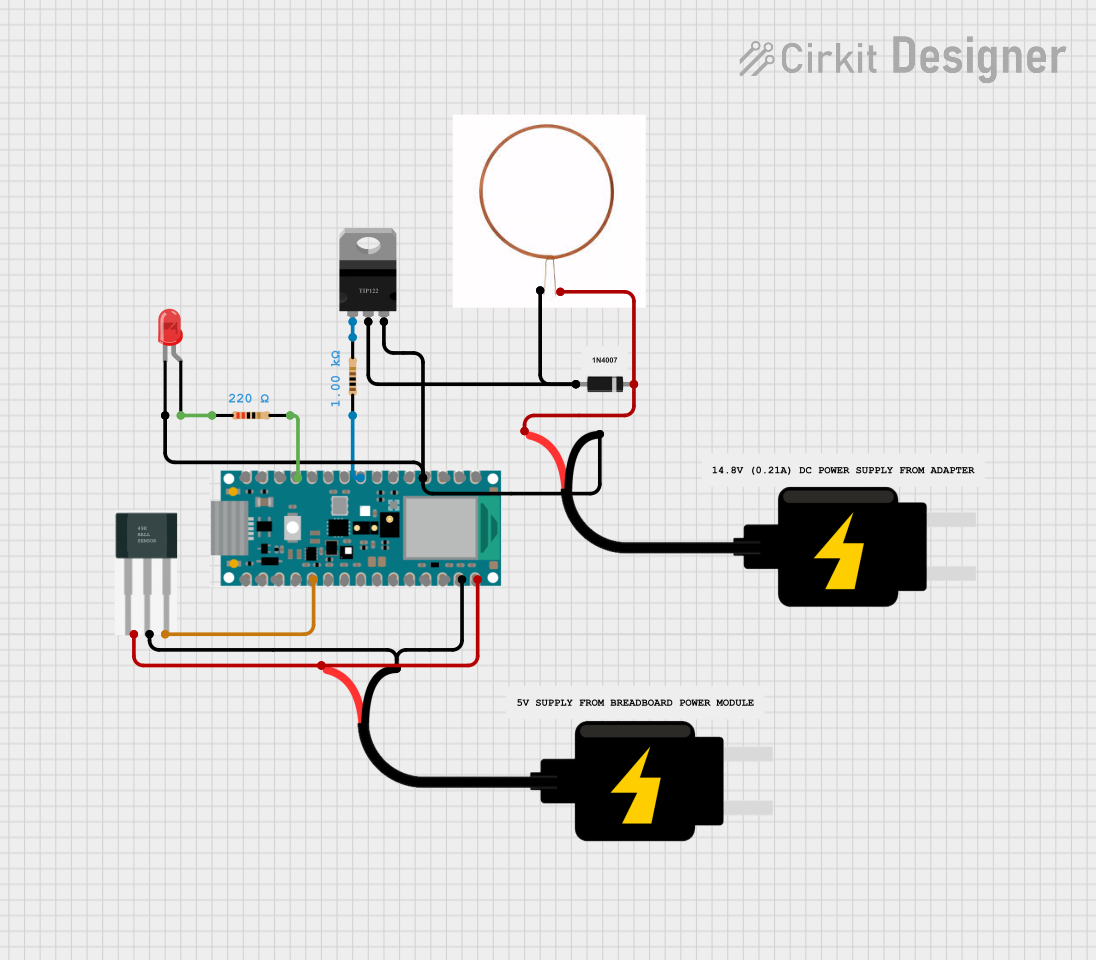
How to Use A3144 Magnetic Hall Effect Sensor: Examples, Pinouts, and Specs

 Design with A3144 Magnetic Hall Effect Sensor in Cirkit Designer
Design with A3144 Magnetic Hall Effect Sensor in Cirkit DesignerIntroduction
The A3144 is a magnetic Hall effect sensor designed to detect the presence of a magnetic field. It operates as a digital sensor, outputting a HIGH or LOW signal depending on the presence or absence of a magnetic field. This makes it ideal for applications such as position sensing, speed detection, and proximity sensing. The A3144 is widely used in automotive, industrial, and consumer electronics due to its reliability and simplicity.
Explore Projects Built with A3144 Magnetic Hall Effect Sensor

 Open Project in Cirkit Designer
Open Project in Cirkit Designer
 Open Project in Cirkit Designer
Open Project in Cirkit Designer
 Open Project in Cirkit Designer
Open Project in Cirkit Designer
 Open Project in Cirkit Designer
Open Project in Cirkit DesignerExplore Projects Built with A3144 Magnetic Hall Effect Sensor

 Open Project in Cirkit Designer
Open Project in Cirkit Designer
 Open Project in Cirkit Designer
Open Project in Cirkit Designer
 Open Project in Cirkit Designer
Open Project in Cirkit Designer
 Open Project in Cirkit Designer
Open Project in Cirkit DesignerCommon Applications
- Position Sensing: Detecting the position of moving parts in machinery.
- Speed Detection: Measuring the rotational speed of motors or wheels.
- Proximity Sensing: Detecting the presence of objects in automation systems.
- Magnetic Switches: Acting as a contactless switch in various devices.
Technical Specifications
The A3144 is a 3-pin device with the following key specifications:
| Parameter | Value |
|---|---|
| Operating Voltage | 4.5V to 24V |
| Output Type | Digital (Open Collector) |
| Output Current (Max) | 25mA |
| Magnetic Sensitivity | Operates with a south pole |
| Operating Temperature | -40°C to +150°C |
| Response Time | 3 µs (typical) |
Pin Configuration and Descriptions
The A3144 has three pins, as described in the table below:
| Pin Number | Name | Description |
|---|---|---|
| 1 | VCC | Power supply input (4.5V to 24V) |
| 2 | GND | Ground connection |
| 3 | OUT | Digital output signal (LOW when magnetic field detected) |
Usage Instructions
How to Use the A3144 in a Circuit
- Power the Sensor: Connect the VCC pin to a power supply (4.5V to 24V) and the GND pin to ground.
- Connect the Output: Attach the OUT pin to a pull-up resistor (e.g., 10kΩ) and then to the input pin of a microcontroller or other digital logic circuit.
- Place a Magnet: Position a magnet near the sensor. The sensor will output a LOW signal when a south pole magnetic field is detected.
Circuit Diagram
Below is a simple circuit diagram for using the A3144 with an Arduino UNO:
VCC (A3144) ----> 5V (Arduino)
GND (A3144) ----> GND (Arduino)
OUT (A3144) ----> Digital Pin 2 (Arduino) with a 10kΩ pull-up resistor
Arduino Code Example
Here is an example code snippet to read the A3144 sensor output using an Arduino UNO:
// Define the pin connected to the A3144 OUT pin
const int hallSensorPin = 2;
void setup() {
pinMode(hallSensorPin, INPUT); // Set the sensor pin as input
Serial.begin(9600); // Initialize serial communication
}
void loop() {
int sensorState = digitalRead(hallSensorPin); // Read the sensor state
if (sensorState == LOW) {
// Magnetic field detected
Serial.println("Magnet detected!");
} else {
// No magnetic field detected
Serial.println("No magnet detected.");
}
delay(500); // Wait for 500ms before the next reading
}
Important Considerations and Best Practices
- Magnet Orientation: The A3144 is sensitive to the south pole of a magnet. Ensure proper orientation for accurate detection.
- Pull-Up Resistor: Always use a pull-up resistor on the OUT pin to ensure a stable digital signal.
- Power Supply: Use a stable power supply within the specified voltage range to avoid erratic behavior.
- Placement: Avoid placing the sensor near strong electromagnetic interference (EMI) sources, as this may affect its performance.
Troubleshooting and FAQs
Common Issues and Solutions
No Output Signal:
- Cause: Incorrect wiring or missing pull-up resistor.
- Solution: Double-check the wiring and ensure a pull-up resistor is connected to the OUT pin.
False Triggering:
- Cause: Electromagnetic interference or unstable power supply.
- Solution: Use proper shielding and a decoupling capacitor (e.g., 0.1µF) across the VCC and GND pins.
Sensor Not Detecting Magnet:
- Cause: Magnet orientation or insufficient magnetic field strength.
- Solution: Ensure the south pole of the magnet is facing the sensor and use a stronger magnet if necessary.
FAQs
Q: Can the A3144 detect both poles of a magnet?
A: No, the A3144 is designed to detect only the south pole of a magnet.
Q: What is the maximum distance for magnetic field detection?
A: The detection range depends on the strength of the magnet. Typically, it is a few millimeters for standard magnets.
Q: Can I use the A3144 with a 3.3V microcontroller?
A: Yes, but ensure the pull-up resistor is connected to the 3.3V supply, and the sensor's VCC is within its operating range (4.5V to 24V).
Q: Is the A3144 suitable for high-speed applications?
A: Yes, with a typical response time of 3 µs, the A3144 is suitable for high-speed sensing applications.